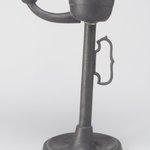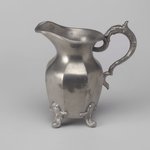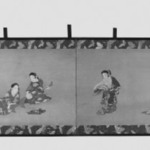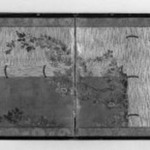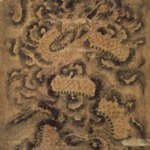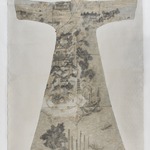
Amit'a (Amitabha) with Six Bodhisattvas and Two Arhats
Asian Art
MEDIUM
Ink and colors on silk
DATES
19th century
DYNASTY
Joseon Dynasty
DIMENSIONS
31 3/4 x 35 1/4 in. (80.6 x 89.5 cm) (show scale)



COLLECTIONS
Asian Art
ACCESSION NUMBER
86.260.2
CREDIT LINE
Gift of Mr. and Mrs. Herbert Greenberg
CATALOGUE DESCRIPTION
From "Korean Art Collection in the Brooklyn Museum" catalogue:
Hanging scroll mounted on panel
This Buddhist painting features Amitabha Buddha attended by: four bodhisattvas, Avalokitesvara, Mahasthamaprapta, Maitreya, and Ksitigarbha; two disciples, MahaKasyapa and Ananda; and two devas, Brahma and Indra. The principal figure, Amitabha Buddha, is seated cross-legged on a low square lotus seat, making the dharmacakra mudra, indicating that he is giving a sermon. Panduravasini wears a white robe with bejeweled crown, while Mahasthamaprapta holds a white porcelain bowl. The third attendant Kshitigarbha is wearing a hood and holds a magic pearl (cintamani) and a staff in his hands. The two guardian devas have third eyes on their foreheads and have their hands pressed in prayer. Unlike Bodhisattvas, who wear "heavenly robes" that expose their chests, the guardians wear robes that cover the entire body below the neck. MahaKasyapa and Ananda, who appear as an old and a young man, respectively, face each other with their hands clasped in prayer.
From Accession Card:
Amitabha (Buddha) with Six Bodhisattvas and Two Arhats Seated Buddha flanked by a group of four standing Bodhisattvas on each side, mainly in bright mineral colors of red, green and dark blue. The Buddha and Six Bodhisattvas in this painting also represent Ch'il Song, The Seven Star Spirits. Confucianism was the official state religion of the Yi Dynasty. Although the government persecuted Buddhists severely, Buddhism survived in Korea as a kind of folk religion with a large admixture of Shamanist and Taoist elements. The Seven Star Spirits were Taoist deities assimilated by Korean Shamanism and subsequently by Korean Buddhism. The Seven Stars are those of Ursa Major, the Big Dipper, which is visible throughout the year from the northern hemisphere. Several other stars and constellations were deified by Chines Taoists, but the Big Dipper was the most important because it was thought to bestow good and bad luck. Seven was considered a lucky number in the Far East. The Big Dipper's seven stars were paralleled by the seven "stars" of the face: Two eyes, two ears, two nostrils and a mouth. A person's destiny was thought to be controlled by the Seven Star Spirits. Therefore, it was important that a Korean Buddhist pay his respects and make a monetary offering in the Seven Star Shrine inside the compound of a Buddhist temple.
MUSEUM LOCATION
This item is not on view
CAPTION
Amit'a (Amitabha) with Six Bodhisattvas and Two Arhats, 19th century. Ink and colors on silk, 31 3/4 x 35 1/4 in. (80.6 x 89.5 cm). Brooklyn Museum, Gift of Mr. and Mrs. Herbert Greenberg, 86.260.2 (Photo: Brooklyn Museum, 86.260.2.jpg)
IMAGE
overall, 86.260.2.jpg. Brooklyn Museum photograph
"CUR" at the beginning of an image file name means that the image was created by a curatorial staff member. These study images may be digital point-and-shoot photographs, when we don\'t yet have high-quality studio photography, or they may be scans of older negatives, slides, or photographic prints, providing historical documentation of the object.
RIGHTS STATEMENT
No known copyright restrictions
This work may be in the public domain in the United States. Works created by United States and non-United States nationals published prior to 1923 are in the public domain, subject to the terms of any applicable treaty or agreement.
You may download and use Brooklyn Museum images of this work. Please include caption information from this page and credit the Brooklyn Museum. If you need a high resolution file, please fill out our online application form (charges apply).
The Museum does not warrant that the use of this work will not infringe on the rights of third parties, such as artists or artists' heirs holding the rights to the work. It is your responsibility to determine and satisfy copyright or other use restrictions before copying, transmitting, or making other use of protected items beyond that allowed by "fair use," as such term is understood under the United States Copyright Act.
The Brooklyn Museum makes no representations or warranties with respect to the application or terms of any international agreement governing copyright protection in the United States for works created by foreign nationals.
For further information about copyright, we recommend resources at the United States Library of Congress, Cornell University, Copyright and Cultural Institutions: Guidelines for U.S. Libraries, Archives, and Museums, and Copyright Watch.
For more information about the Museum's rights project, including how rights types are assigned, please see our blog posts on copyright.
If you have any information regarding this work and rights to it, please contact copyright@brooklynmuseum.org.
RECORD COMPLETENESS
Not every record you will find here is complete. More information is available for some works than for others, and some entries have been updated more recently. Records are frequently reviewed and revised, and we welcome any additional information you might have.

